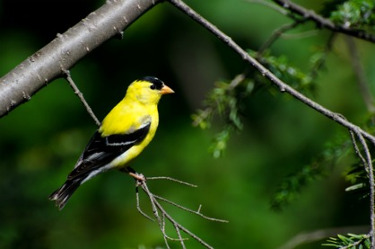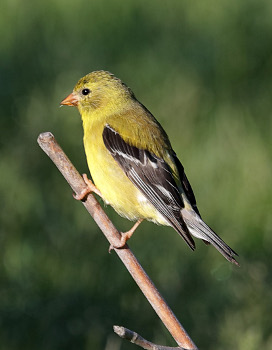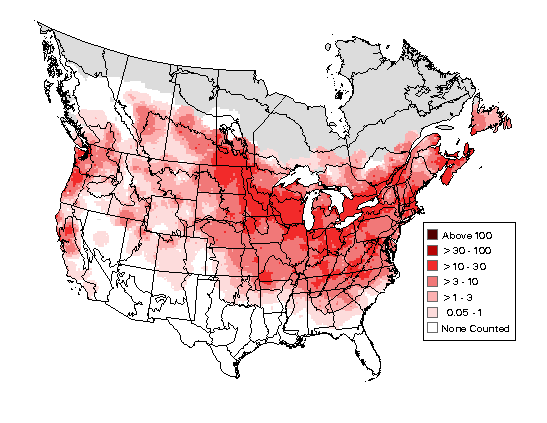American Goldfinch

American Goldfinch Information
Length: 4.5 - 5 "
Habitat:
The American Goldfinch is found in weedy fields, open areas with scattered trees, and woodland edges. They are also seen near roadsides and in thickets, shrubby wetlands, as well as residential areas with trees.
Diet:
The American Goldfinch mainly eats seeds of grasses, thistles, ragweed, dandelions and small seeds of trees. In the spring, it will also feed on buds. This bird will occasionally eat insects. Goldfinches feed regurgitated seeds to their young, in contrast to most songbirds which feed insects to their baby birds.
Photo of American Goldfinch pair at nest
Photo of American Goldfinch at nest with young
Facts about the
American Goldfinch
- The American Goldfinch is one of the latest songbirds to begin nesting. In New England, breeding usually occurs in the late summer. Since thistle down is commonly used for nest building, breeding typically coincides with the time when thistles produce their seed.
- Goldfinches are usually monogamous for each breeding season, but will change mates from one year to the next.
- This small bird can be recognized, not only by the male's bright yellow summer plumage and black wings, but also by its roller coaster-like flight. Each time it dips downward, it sings its "per-chick-o-ree" song.
- Goldfinches are highly gregarious and will usually flock together during the nonbreeding season. They are often joined by Pine Siskins, Common Redpolls, and American Tree Sparrows.
- After the breeding season is over and molting begins, some of these birds will migrate to a warmer climate. Migration allows them to escape the cold winter temperatures while also giving access to a wider selection of food sources.
However, some American Goldfinches in northern areas will overwinter at locations where they can find food at backyard bird feeders. They will fly as far as 4 miles when moving from one feeding station to the next.
Preferred Bird Feeder Food
The American Goldfinch's favorite feeder foods are nyjer seeds, whole sunflower seeds and hulled sunflower seeds.
This bird will come to most types of feeders: tubes, platform feeders, and hoppers. It also readily feeds on the ground. When offering nyjer seeds, special feeders with a fine mesh are often used, as well as sock feeders.
American Goldfinch - Breeding Female

American Goldfinch
Identification Tips
- Small, seed-eating bird
- Short, conical bill
- Short, forked tail
- Plumage held in Spring and Summer
- Black forehead
- Yellow head, back, breast and belly
- Black wings and tail
- White wing bars and tertial edges
- White rump and undertail coverts
- Pale bill and legs
- Greenish upperparts
- Yellow underparts
- Pale bill and legs
- Plumage held in Fall and Winter
- Yellow face
- Brownish-olive upperparts
- Whitish underparts
- Blackish wings with pale wing bars
(Credit: U. S. Geological Survey)
American Goldfinch
Breeding Bird Survey Map,
2011-2015

(Image credit: USGS)
American Goldfinch
Range Maps from Cornell
American Goldfinch breeding, nonbreeding, and year-round range
Includes separate map of sightings.
American Goldfinch
Christmas Bird Count Map
Historical CBC Map from USGS